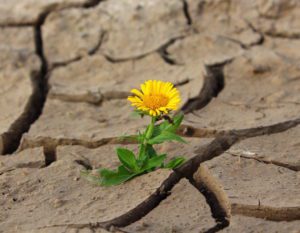I am looking out my window and thinking that it looks like fall. Leaves are beginning to fall on the ground and the trees are turning color as they usually do in October. What is odd, is that at the same time it is 90 degrees F in August. Where I live, we are experiencing a drought. Normal water use for lawns and gardens is banned or limited. Nature is starting the process of hibernating for the winter to conserve resources and protect plant life for next spring.
As nature taps the power of limits in response to the drought, I am seeing signs of this simple principle all around. Reduced moisture and high heat are triggering limits to the normal growth patterns this time of year. My plants aren’t uprooting themselves to protest the heat and drought, but they are accepting and adapting to them.
In our culture here in the United States, this might be framed as “giving up or giving in” to the “outside authority” found in nature. But nature doesn’t see this event like a fight – and it doesn’t bring any ego to it. It acknowledges the limits of what is occurring and works to serve the higher purpose of ensuring the life of future generations. Conversely, as humans, we tend to see a limit like this drought as a challenge to overcome, ignore, or stretch.
The Problem with Ignoring Limits in Life
Speaking of limits when it comes to our planet, I have been reading the latest Intergovernmental Panel on Climate Change (IPCC) report. The report is written every seven years and reviewed prior to publication by the governments of 198 countries. Volunteer scientists from around the world work together to analyze data and generate the report. This year, 234 authors from 65 countries contributed to the findings.
Here are the main take-a-ways from the 2021 IPPC Report:
- The Earth is on track to cross the critical 1.5°C carbon emission threshold within 20 years, which will result in warmer temperatures, melting polar regions, and higher sea levels.
- Warming is ‘unequivocally’ due to human activity.
- We can still prevent the worst climate hazards, perhaps the direst being a rising carbon emission beyond 1.5 degrees up to a possible 7-degree increase Fahrenheit which would result in a 6-foot rise in sea levels by the end of the century.
Just like we bent the curve on COVID infections and death to respond to the pandemic, we can still bend the curve of carbon emissions to lower over time if we acknowledge the limits of our natural world NOW. These limits are giving us feedback that our habits and behaviors as humans are significantly damaging our world and making future life on this planet more hostile to life in all its forms. To bend the curve 15-20 years from now, we have to act quickly to acknowledge the limits of our world and adapt our behavior, habits, and consumption to create the possibility of a more habitable environment.
Life Thrives within Limits
Nature teaches us that climate, temperature, moisture and soil composition all limit what grows where across our globe. One thing remains clear, within these limits the plants and trees that grow there will continue to thrive. Obviously, what grows in my garden is different from what grows in a more arid or hotter climate. My cold winters are survivable for my oak trees, daylilies and irises because they fit the limits of the local environment in which they grow.
What would happen if humans became as smart as our plants and shifted our habits to fit the limits being set out for a thriving world in the future?







Thank you.